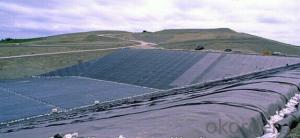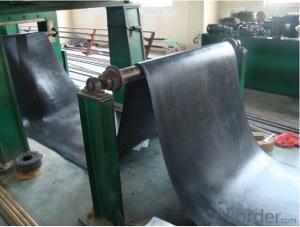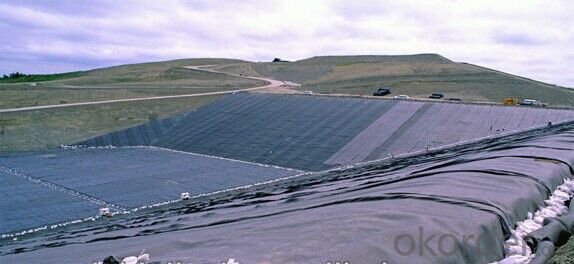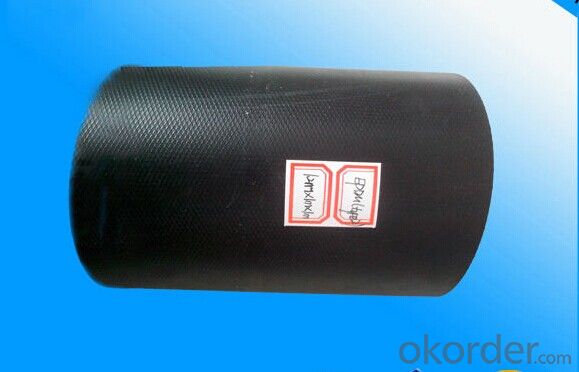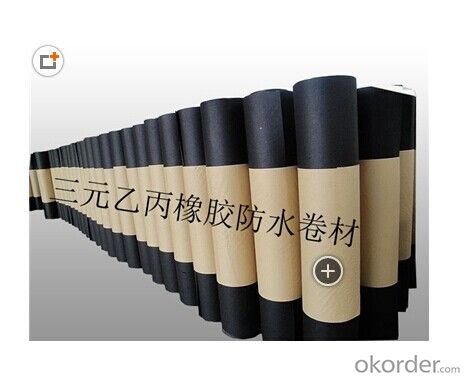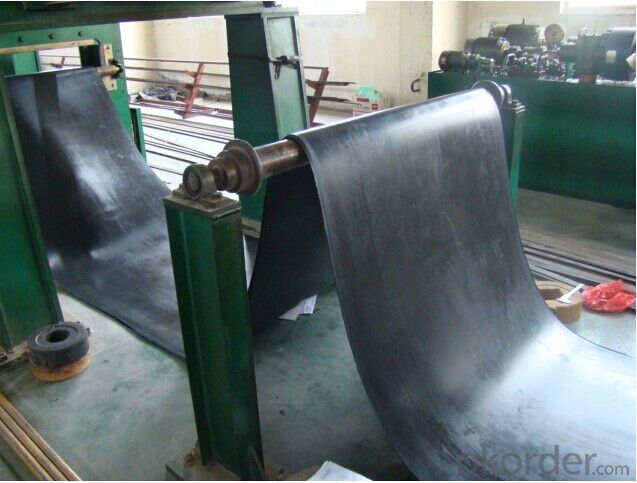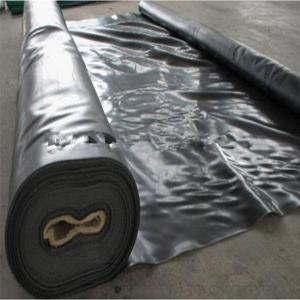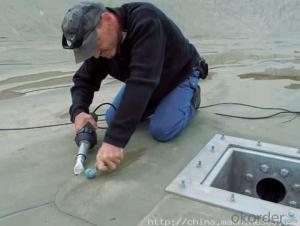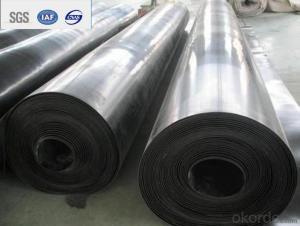EPDM Rubber Roofing Waterproof Membrane with 1.2mm/1.5mm/2.0mm
- Loading Port:
- Qingdao
- Payment Terms:
- TT OR LC
- Min Order Qty:
- 2000 m²
- Supply Capability:
- 300000 m²/month
OKorder Service Pledge
OKorder Financial Service
You Might Also Like
EPDM Waterproof Membrane
Introduction for EPDM Waterproof Membrane
EPDM waterproof membrane is of high elasticity among high polymer waterproof materials and becomes a world-popular waterproofing material.
Our EPDM waterproof membrane is made from ternary ethylene-propylene rubber, which is designed for waterproofing of exposed and non-exposed applications.
Our EPDM waterproof membrane production adopts the world-advanced equipment of cold feeding extrusion and continuous vulcanization technology.
Characteristics for EPDM Waterproof Membrane
1 Excellent physical and mechanical performance
2 High tearing resistance
3 Good deformation adaptability
4 High puncture resistance
5 High aging resistance
6 High UV resistance
Uses for EPDM Waterproof Membrane
l Roofs, Basement, Toilet
l Industrial and civil building waterproofing
l Geosynthetic liner for swimming pool, channels, irrigation system
l Especially suit for projects with high requirements in durability, anti-corrosion and deformation
Specification for EPDM Waterproof Membrane
Type | EPDM Waterproof Membrane | |||
Material | EPDM Rubber | |||
Thickness | 1.0mm | 1.2mm | 1.5mm | 2.0mm |
Size | 1.2m(width) * 20m(length)/roll | |||
Type | Vulcanized | |||
Pattern | Non-reinforced(homogeneous) | |||
Packing | 24sqm--80sqm/roll, with plastic bag | |||
Color | Black | |||
Application | Roofs, basement, pond, Lake, steel structure roof, swimming pool, underground, tunnel, etc | |||
Technical Data for EPDM Waterproof Membrane
Item | value | ||
JL1 | JF1 | ||
Tensile Strength (Mpa) | normal tamperature | 7.5 | 4.0 |
60°C ≥ | 2.3 | 0.8 | |
Elongation at break (%) | normal tamperature ≥ | 450 | 450 |
-20°C ≥ | 200 | 200 | |
Tear Resistance (N) | ≥ | 25 | 18 |
Water impermeability | 30mm | 0.3Mpa | 0.3Mpa |
Cold bending | (°C) ≤ | -40 | -30 |
Heating Shrinking rate | extand << span=""> | 2 | 2 |
shrink << span=""> | 4 | 4 | |
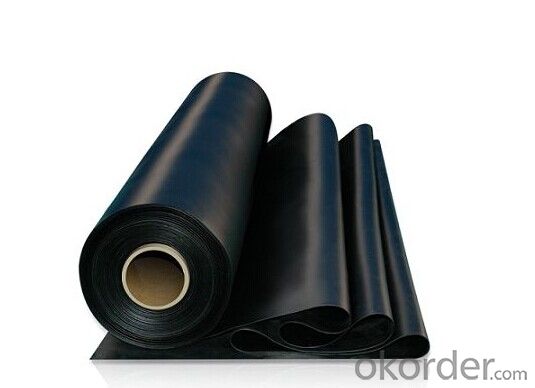

FAQ:
Can you produce 4m width?
Yes, no problem for us. We have four bases in China, largest one in this field.
How many quantity in one 20'' container for 1.2mm and 1.5mm?
480rolls, 11520m2 for 1.2mm and 400rolls, 9600m2 for 1.5mm
Can you provide free samples?
Yes, our samples are free, but express fees usually on buyer's account.
- Q: Polyurethane and SBS membrane waterproof
- ?Asphalt waterproof material with natural asphalt, petroleum asphalt and coal asphalt as the main raw material, with good adhesion, plasticity, water resistance, corrosion resistance and durability. Asphalt has been used as a waterproof material for more than 100 years and is widely used in civil engineering. Since the 1930s, oil asphalt gradually replaced the other asphalt, has become the main varieties of asphalt. Asphalt oil felt for the tire waterproofing membrane. At present, the varieties of linoleum oil asphalt felt, coal asphalt felt, glass cloth linoleum, glass fiber mats linoleum and linen linoleum and so on. Some countries also develop heat-resistant linoleum, porous linoleum, hot melt linoleum and low-burned linoleum. Conventional paper tires Asphalt felt is still the main varieties of waterproofing membrane, the bonding material is hot asphalt or in the hot asphalt mixed with inorganic or organic modified materials prepared asphalt glue (Methanol)
- Q: Can a waterproofing membrane be used for water features or fountains?
- Yes, a waterproofing membrane can be used for water features or fountains. Waterproofing membranes are specifically designed to prevent water from penetrating through surfaces, making them an ideal choice for water-related applications. These membranes create a barrier that keeps water contained within the desired area, preventing leaks or seepage. Additionally, some waterproofing membranes have additional properties such as resistance to UV rays and chemicals, which can be beneficial in water features or fountains that are exposed to sunlight or treated with water treatment chemicals. Overall, using a waterproofing membrane ensures that water features or fountains remain watertight and functional.
- Q: Can a waterproofing membrane be used on asphalt surfaces?
- Indeed, asphalt surfaces can benefit from the application of a waterproofing membrane. These membranes, widely employed in construction, are specifically engineered to safeguard against water infiltration. Their versatility allows for application on diverse surfaces, asphalt included. By applying a waterproofing membrane on an asphalt surface, one can effectively thwart water damage, prolong the surface's lifespan, and safeguard the underlying structures. It is crucial to guarantee the compatibility of the chosen waterproofing membrane with asphalt and to adhere to proper installation techniques in order to achieve the best possible outcome.
- Q: Can waterproofing membranes be used in cold climates?
- Yes, waterproofing membranes can be used in cold climates. They are designed to withstand extreme temperatures, including freezing conditions, and provide effective protection against water penetration.
- Q: How does a waterproofing membrane handle freeze-thaw cycles?
- A waterproofing membrane is designed to withstand freeze-thaw cycles by having specific properties that enable it to expand and contract without compromising its integrity. Freeze-thaw cycles occur when water penetrates the membrane and freezes during colder temperatures, causing it to expand. As the ice melts during warmer temperatures, the membrane should have the ability to contract back to its original state. To handle freeze-thaw cycles, a waterproofing membrane typically possesses elasticity and flexibility, allowing it to accommodate the expansion and contraction without cracking or breaking. It may also have a low water absorption rate to prevent water from seeping into the membrane. Additionally, the membrane should have excellent adhesion to the substrate to ensure it remains in place during temperature fluctuations. Some waterproofing membranes incorporate special additives or technology to enhance their freeze-thaw resistance. These additives may include polymers or elastomers that improve the membrane's ability to withstand extreme temperature changes. Moreover, some membranes have reinforced layers or fabric inserts that provide additional strength and durability, helping them better handle freeze-thaw cycles. Overall, a well-designed waterproofing membrane should be able to handle freeze-thaw cycles effectively by being elastic, flexible, resistant to water absorption, and strongly adhered to the substrate. This ensures the membrane's longevity and prevents water infiltration, protecting structures from potential damage caused by freeze-thaw cycles.
- Q: Can a waterproofing membrane be used on precast iron surfaces?
- Yes, a waterproofing membrane can be used on precast iron surfaces. A waterproofing membrane is a thin layer of material that is applied to a surface to prevent the penetration of water or moisture. It can be applied to a variety of surfaces, including precast iron surfaces. The waterproofing membrane acts as a barrier, preventing water from seeping into the precast iron and causing damage such as rust or corrosion. This can be particularly important in areas where the precast iron surface is exposed to water or moisture, such as in outdoor installations or areas with high humidity levels. The use of a waterproofing membrane on precast iron surfaces can help to extend the lifespan of the structure and maintain its structural integrity.
- Q: Can a waterproofing membrane be used on brick block surfaces?
- Brick block surfaces can indeed benefit from the application of a waterproofing membrane. These membranes are widely used to create a barrier against water infiltration and safeguard buildings from moisture damage. When applied correctly, they effectively seal brick block surfaces, safeguarding against water penetration and promoting the structure's longevity and durability. Acting as a protective layer, the membrane prevents water from seeping into the bricks and causing issues like deterioration, cracking, or mold growth. It is crucial to choose a waterproofing membrane specifically designed for brick block surfaces and meticulously follow the manufacturer's instructions for proper application. Moreover, seeking guidance from a professional contractor experienced in waterproofing is highly recommended to ensure optimal outcomes and long-term performance.
- Q: How does a waterproofing membrane handle moisture from the ground?
- A waterproofing membrane is designed to effectively handle moisture from the ground by creating a barrier that prevents water infiltration. It is typically made from materials such as rubber, bitumen, or modified asphalt, which are impermeable to water. When installed correctly, the membrane forms a continuous, watertight layer that prevents water from seeping through the foundation or walls. The membrane is typically installed on the exterior side of a building's foundation, where it acts as a protective barrier against groundwater. It is applied directly onto the concrete or masonry surface, creating a seamless and durable waterproofing layer. The membrane is then covered with a protective layer, such as soil or backfill, to ensure its long-term integrity. In addition to its impermeable properties, a waterproofing membrane also incorporates features that allow it to handle moisture effectively. For instance, it may have built-in channels or dimples that allow water to drain away from the foundation, preventing the accumulation of hydrostatic pressure. Some membranes also have self-healing properties, meaning they can seal small punctures or cracks that may occur over time. Overall, a properly installed waterproofing membrane acts as a reliable barrier against moisture from the ground. It helps protect the structure from water damage, prevents the growth of mold and mildew, and maintains a dry and healthy indoor environment. However, it is essential to ensure that the membrane is installed correctly by following the manufacturer's guidelines and working with experienced professionals to ensure its effectiveness.
- Q: Can a waterproofing membrane be used in residential construction?
- Residential construction can indeed utilize a waterproofing membrane. These membranes find common usage in different parts of a residential property, such as roofs, basements, bathrooms, and foundations. Their purpose is to prevent water from penetrating and causing damage due to moisture. By opting for a waterproofing membrane, homeowners can ensure that their property remains dry and free from water leaks. This is crucial because such leaks can result in mold growth, structural deterioration, and other costly problems. The market offers a variety of waterproofing membranes, such as sheet membranes, liquid membranes, and self-adhering membranes, each with its own advantages and suitability for specific applications. Consulting with a professional contractor or architect can assist in determining the most suitable waterproofing membrane for a particular residential construction project.
- Q: Can a waterproofing membrane be installed on wood surfaces?
- Yes, a waterproofing membrane can be installed on wood surfaces.
Send your message to us
EPDM Rubber Roofing Waterproof Membrane with 1.2mm/1.5mm/2.0mm
- Loading Port:
- Qingdao
- Payment Terms:
- TT OR LC
- Min Order Qty:
- 2000 m²
- Supply Capability:
- 300000 m²/month
OKorder Service Pledge
OKorder Financial Service
Similar products
Hot products
Hot Searches
Related keywords
